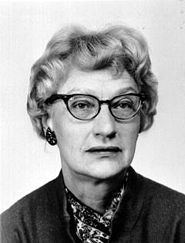Occupation Linguist Name Mary Haas | Role Linguist | |
 | ||
Known for Training linguists; work in North American Indian languages; work in Thai, and historical linguistics. Died May 17, 1996, Alameda County, California, United States Books Thai‑English student's dictionary, The Thai system of writing, Spoken Thai, Thai Vocabulary, Creek (Muskogee) Texts Similar People | ||
Mary haas interview
Mary Rosamund Haas (January 23, 1910 – May 17, 1996) was an American linguist who specialized in North American Indian languages, Thai, and historical linguistics.
Contents
- Mary haas interview
- Early life
- Early work in linguistics
- Marriage and family
- Role in teaching
- Work on Thai
- References
Early life
Haas was born in Richmond, Indiana. She attended high school and Earlham College in Richmond.
Early work in linguistics
Haas undertook graduate work on comparative philology at the University of Chicago. She studied under Edward Sapir, whom she would follow to Yale. She began a long career in linguistic fieldwork, studying various languages during the summer months.
Over the ten-year period from 1931 to 1941, Haas studied Nitinat, Tunica, Natchez, Creek, Koasati, Choctaw, Alabama, and Hichiti, mostly languages of the American southeast. Her first published paper, A Visit to the Other World, a Nitinat Text, written in collaboration with Morris Swadesh, was published in 1933.
She completed her PhD in linguistics at Yale University in 1935 at age 25, with a dissertation titled A Grammar of the Tunica Language. In the 1930s, Haas worked with the last native speaker of Tunica, Sesostrie Youchigant, producing extensive texts and vocabularies.
Shortly after, Haas conducted fieldwork with Watt Sam and Nancy Raven, the last two native speakers of the Natchez language in Oklahoma. Her extensive unpublished field notes have constituted the most reliable source of information on the now dead language. She conducted extensive fieldwork on the Creek language, and was the first modern linguist to collect extensive texts in the language. Most of her notes on Creek and Natchez remain unpublished, but they are being used by linguists in the 21st century.
Marriage and family
She married Morris Swadesh, also a linguist. They divorced in 1937.
Role in teaching
Haas was noted for her dedication to teaching linguistics, and to the role of the linguist in language instruction. Her student Karl V. Teeter pointed out in his obituary of Haas that she trained more Americanist linguists than her former instructors Edward Sapir and Franz Boas combined: she supervised fieldwork in Americanist linguistics by more than 100 doctoral students. She was a founder and director of the Survey of California Indian Languages, in this capacity she advised nearly fifty dissertations, including those of many linguists who would go on to be influential in the field, including William Bright (Karok), William Shipley (Maidu), Robert Oswalt (Kashaya), Karl Teeter (Wiyot), Margaret Langdon (Diegueño), Sally McLendon (Eastern Pomo), Victor Golla (Hupa), Marc Okrand (Mutsun), Kenneth Whistler (Proto-Wintun), Douglas Parks (Pawnee and Arikara), William Jacobsen (Washo), and others.
Work on Thai
During World War II, the United States government viewed the study and teaching of Southeast Asian languages as important to the war effort, and under the auspices of the Army Specialized Training Program at the University of California at Berkeley, Haas developed a program to teach the Thai language. Her authoritative Thai-English Students' Dictionary, published in 1964, is still in use.
She was appointed to a permanent position at the University of California, Berkeley Department of Oriental Languages, an appointment she attributed to Peter A. Boodberg, whom she described as "ahead of his time in the way he treated women scholars—a scholar was a scholar in his book").
In 1963, Haas served as president of the Linguistic Society of America. She was elected a fellow of the American Academy of Arts and Sciences in 1974. She received honorary doctorates from Northwestern University in 1975, the University of Chicago in 1976, Earlham College, 1980, and Ohio State University in 1980.
Mary Haas died on May 17, 1996 in Alameda County, California, age 86.
